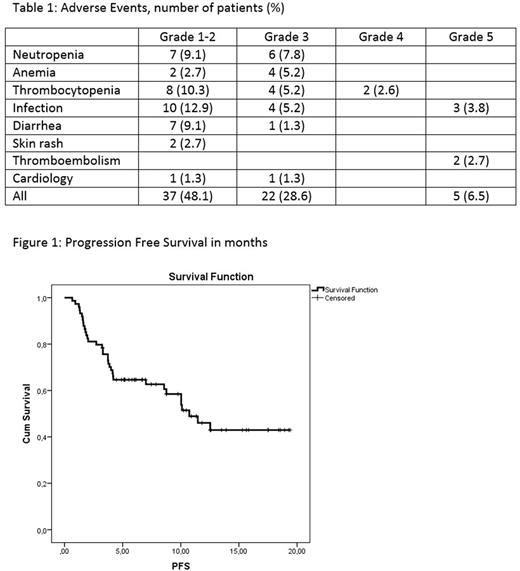Abstract
Background: Ixazomib-lenalidomide-dexamethasone (IRD) is an all-oral treatment protocol which showed remarkable efficacy and safety in the TOURMALINE-MM1 trial leading to its approval in relapsed/refractory multiple myeloma (MM). However clinical trials are different from real world use for many reasons including less rigorous patient selection, greater flexibility with dosing and country specific funding restrictions making real world data very important for clinicians. Regarding IRD real world data is currently very limited.
Aims and Methods: The aim of this study was to evaluate the efficacy and safety of IRD in the real world practice in a retrospective analysis using case records of patients taking part in the Hungarian Ixazomib Named-Patient Program. The scope of this study was to analyze response rate, progression free survival (PFS), treatment duration, adverse events (AEs), dose modifications and treatment discontinuations. Patients who have not completed at least one cycle were excluded. Statistical analyses were performed using the SPSS (version 20.0) software package.
Results: 77 patients were treated at 7 sites. Patients were heavily pretreated, 29, 34 and 37% had 1, 2 and 3 lines of prior treatment which included a proteasome inhibitor in all and an IMiD in all but one patients. 60% had an autologous transplantation, 37% had high risk cytogenetics. Treatment continued until progression, unacceptable toxicity or death, the median number of IRD cycles applied was 5.5. AEs over grade 3 were uncommon, the most frequent AEs were cytopenias, infections and diarrhea (Table 1), leading to dose reduction in 6 patients. Overall response rate was 60% with 40% partial, 8% very good partial, and 12% complete responses. 19% showed stable disease, 16% progressive disease, and 5% of the patients had no formal disease re-assessment due to early death. With 8.5 months median follow up and 52% of patients still on treatment the 12 month PFS was 46% in all patients and 55% in those reaching at least stable disease (Figure 1). The known prognostic markers (fluorescence in situ hybridization, international staging system) all affected the outcome, and patients with high risk clinical features (plasma cell leukemia, extramedullary disease, central nervous system myeloma) had poor outcome.
Conclusion: Our results highlight the differences between patients treated in routine practice and those treated in clinical trials. In our dataset less than a third of patients were treated at first relapse, whereas in the TOURMALINE trial the majority were. Also, in the TOURMALINE trial only 21% had high risk cytogenetics which was 37% in our patients. This probably accounts for the shorter PFS observed in our heavily pretreated patient group. Based on our results IRD is an effective treatment option for relapsed/refractory MM with good safety profile.
No relevant conflicts of interest to declare.
Author notes
Asterisk with author names denotes non-ASH members.


This feature is available to Subscribers Only
Sign In or Create an Account Close Modal